Latest news about Bitcoin and all cryptocurrencies. Your daily crypto news habit.
This week, CRV portfolio company Bird publicly announced a new platform for independent operators to manage their own scooter fleets. Bird will sell the scooters and provide access to a marketplace of chargers and mechanics in exchange for a 20% revenue share. We’re incredibly excited about this program, as it allows Bird to quickly expand geographically while giving operators the chance to build a great business on top of a fantastic product.
This effort from Bird fits perfectly within a category that we have huge excitement around — the “business in a box.” These platforms give entrepreneurs the opportunity and infrastructure to run a business without the convoluted and expensive process of building a company from scratch. Entrepreneurs also benefit from the brand and budget of the parent company, as well as other value-add services like accounting, legal, and marketing.
The “business in a box” model allows for significant de-risking of product-market fit (which is very hard to achieve!) by providing a proven product to sell. Nearly 55% of small businesses in the U.S. fail within the first two years, and 40% of these failures are due to the fact that there’s no market for the product or service. A “business in a box” removes the “idea risk” from a venture, leaving the entrepreneur with geographic and operating risk.
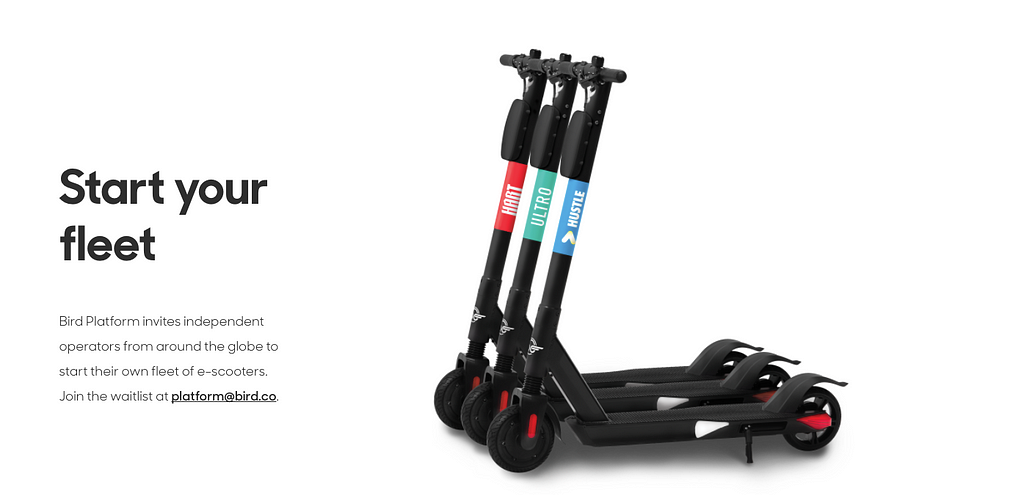 The Bird Platform is set up to let independent operators run their own fleets. Operators upload a logo and choose a sleeve color, and Bird manufactures and delivers the scooters, builds a customized website, and provides fleet management tools. Image courtesy of Bird.
The Bird Platform is set up to let independent operators run their own fleets. Operators upload a logo and choose a sleeve color, and Bird manufactures and delivers the scooters, builds a customized website, and provides fleet management tools. Image courtesy of Bird.
If executed well, these models can be value accretive for both the parent company and the individual operators. The parent company benefits from faster and more capital-efficient geographic growth (no need for market launch or operations teams in each city), lower real estate and inventory risk, and better local execution. The entrepreneur benefits from the ability to be his or her own boss (the American dream!) without having to develop an innovative product and establish a standalone company.
The “business in a box” model has taken many shapes over time, but has a long history — franchises (established in the 1800s), multi-level or “network” marketing (1940s), and more recently gig economy platforms.
We are excited about the next generation of these companies, which we are calling “Internet franchises.” These platforms use software and other tech to scale the franchise model, giving operators the ability to run a business built on the product(s) and infrastructure of a parent company without the physical real estate and capital required for traditional franchises. Unlike gig economy platforms, Internet franchises allow operators to truly “own” their business and accumulate equity value over time.
We’ll briefly review the history of this space and why we think it’s so important to the economy, before getting into what we are looking for in this “Internet franchise” model. We’d love to meet any founders who are working on something new in this space! You can reach us at saar@crv.com, matt@crv.com, and twins@crv.com.
History of the “Business in a Box”
Franchising is an ancient business model — it dates back to the Middle Ages in Europe, when nobility sold the rights to operate and collect taxes on their land. Later, explorers were granted franchises by monarchs to establish (and tax) colonies in the 1500s, and pub owners were paid by breweries to exclusively distribute their beer in the 1700s and 1800s. The franchise model moved to the U.S. in the 1850s, after Isaac Singer sold the rights to distribute his sewing machine to salesmen nationwide (Rosenberg Center).
Over the next century, the franchise model expanded to other industries, from automobiles (General Motors in 1898) to food and beverages (A&W Root Beer in 1924) to cleaning products (Duraclean in 1943). The 1946 Federal Lanham Act, which made it safer to license assets to third parties, and the 1956 Federal-Aid Highway Act, which resulted in increasing urban sprawl (Shane), lit a match under the franchise industry. Between 1950 and 1960, the number of companies with franchise operations increased by almost 10x, and in the 1960s some of the largest franchises (McDonalds, Holiday Inn, KFC) hit the 1,000 store milestone (Franchise Law).
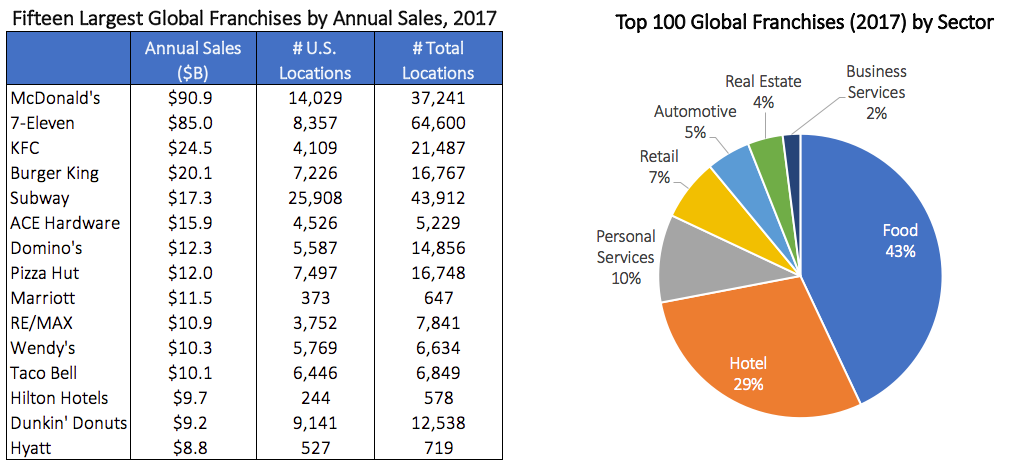 Of the 100 largest global franchises (by revenue) in 2017, the average company made $5.9B in revenue and had 2,322 open locations. Food and hospitality are the largest franchise categories by far.
Of the 100 largest global franchises (by revenue) in 2017, the average company made $5.9B in revenue and had 2,322 open locations. Food and hospitality are the largest franchise categories by far.
Around the same time, multi-level marketing companies (MLMs) emerged as a more capital-efficient model that allowed individuals to directly sell products without requiring a physical location. Whereas franchises can cost hundreds of thousands to millions of dollars to set up (under $50,000 is viewed as “low cost”), entrepreneurs can get involved in an MLM for a few thousand or even a few hundred dollars. The first known U.S. MLM was a company called Nutrilite (1945), a dietary supplement that was licensed by a national distributor and sold door-to-door by 15,000 salesmen.
A number of Nutrilite distributors branched out to start their own companies (including Amway and Shaklee) when they realized how successful the business model could be. Other companies were soon founded around different categories of products, including Avon (beauty products), Tupperware (kitchen products), and Rodan & Fields (skincare). In the past decade, social media has breathed new life into MLMs, allowing salespeople to market to their network at scale on a continuous basis. Despite significant press around scammy behavior, there are ~1,400 MLMs currently active in the U.S., with nearly 20 million recruited salespeople.
The rise of the consumer Internet in the 1990s, followed by the mobile revolution of the 2000s, further lowered the barriers to entry for potential “business in a box” entrepreneurs. Companies like DoorDash, Instacart, and Wag require little more than a car and a smartphone to get started, and some gig economy companies provide training, resources, and a community that mimic some of the better offerings from franchises and MLMs. For example, HopSkipDrive provides new-driver training, a 24-hour support team, meet-ups for drivers to build a community, and bonuses for new families and drivers referred into the platform.
Why This Space is Important
Franchisees, direct salespeople, and gig economy workers receive a lot less attention than founders of venture-backed companies, but their collective impact on the economy is enormous.
By the end of 2017, there were an estimated 3,300 franchisors and 744,000 franchise establishments in the U.S. Franchises directly employed almost 8 million people, represented 10% of non-farm U.S. businesses, and generated $757 billion in output (Rosenberg Center). Some of the largest consumer-facing businesses in the world operate via franchises, including Chevron ($220B market cap), McDonald’s ($142B), and Marriott ($42B).
Direct sales, of which MLMs contribute an estimated 70%+ of revenue, generated $35 billion of revenue in the U.S. in 2017, with 19 million salespeople. Established direct sales companies like Avon and Amway regularly bring in billions in annual revenue ($5.7B and $8.8B, respectively, in 2017), and even relative newcomers like Jeunesse (founded in 2009) and doTERRA (founded in 2008) make more than $1B each year.
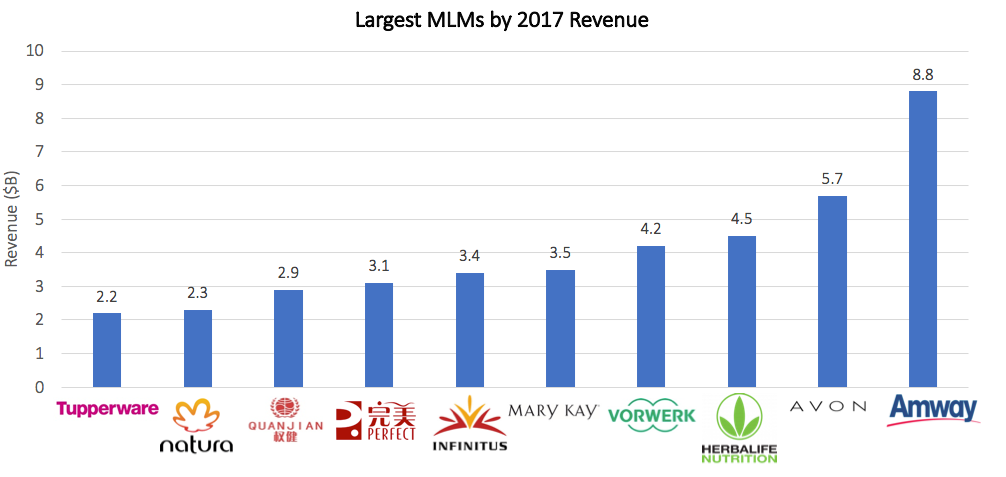 MLMs are a global phenomenon — though five of the ten largest MLMs were founded in the U.S., three are from China (Quanjian, Perfect, and Infinitus), one is from Brazil (Natura), and one is from Germany (Vorwerk).
MLMs are a global phenomenon — though five of the ten largest MLMs were founded in the U.S., three are from China (Quanjian, Perfect, and Infinitus), one is from Brazil (Natura), and one is from Germany (Vorwerk).
The gig economy is difficult to quantify because it’s so large and fragmented, but there’s an estimated 57M gig economy workers in the U.S. (one-third of the working population) who generated nearly $900B in revenue last year. Startups powered by gig economy workers have become some of the most valuable private companies in the world, including Uber ($72B valuation), Lyft ($15B), Instacart ($8B), and DoorDash ($4B).
We believe that the economic impact of these businesses will only continue to grow. These companies also provide a societal benefit by offering employment opportunities to those who may not participate in full-time employment elsewhere. Gig economy platforms allow more flexibility in working hours, while MLMs often employ stay-at-home moms who don’t want a traditional job but can monetize their extensive local networks.
What We’re Looking For
Historically, many franchises have not been venture-backed, as they tend to look more like retail or services businesses in the early days and typically receive debt financing. Direct sales companies have also generally not raised significant venture funding (Stella & Dot and Trumaker are notable counterexamples), as many have been debt-funded or have had scammy products that are unattractive to VCs. Many gig economy companies have been successful venture-backed companies (we’re proud investors in DoorDash!), and we have high hopes for the next iteration of these businesses.
We see this new group of “Internet franchises” as combining the scale of marketplaces with the ownership and incentive structure of franchises.
We believe that recent developments in global shipping and payments will allow capital-light franchises to achieve greater scale than ever before. When retail franchises were first established a century ago, it took years, if not decades, to scale regional operations. Today, a parent company can relatively quickly and cheaply deliver physical goods, payments, content, and marketing to distributors around the world. We’re starting to see early examples of this - Wheelys (bike-powered coffee carts), Tinkergarten (outdoor classes for kids), Robin Autopilot (robotic lawn service), Hotpod Yoga (portable hot yoga studios), and Beeline (mobile bike repair shops) are just a few.
 For $8,999 and a monthly $99 “community fee,” entrepreneurs worldwide can start a business selling coffee through a mobile Wheelys café. The company is backed by YC, and has shipped carts to 800 entrepreneurs in 75+ countries.
For $8,999 and a monthly $99 “community fee,” entrepreneurs worldwide can start a business selling coffee through a mobile Wheelys café. The company is backed by YC, and has shipped carts to 800 entrepreneurs in 75+ countries.
As we look for companies in this space, we’re particularly focused on the following characteristics:
- Abstracts away operational and logistical complexities. Even with help, starting a business is hard and scary. We’re looking for platforms that put a product in the the hands of everyday people and empower them to sell it without needing to hire lawyers, accountants, marketers, and business consultants. One of the reasons McDonald’s franchises have been so successful is that the parent company handles almost all of the infrastructure for franchisees — from the location to the cooking equipment to the menus. The company also provides ongoing training on operational best practices for franchisees, along with marketing support.
- Taps high-quality but under-utilized supply to fill excess demand. New “businesses in a box” will be competing with established companies that have the benefit of a brand, years of expertise, and (potentially) a bigger budget. We think upstarts are most likely to succeed if they fill a supply shortage — if the level of demand for their product or service is high, it will be easier to draw in early users from incumbents. In the childcare space, Wonderschool* and WeeCare have found early success by tackling the recent rise of “childcare deserts” in the U.S., while also giving caregivers (e.g. parents, nurses, former teachers) a way to monetize their expertise.
*WeeCare technically fits more tightly in the “Internet franchise” category, as all of their daycares carry the full WeeCare name and branding, while Wonderschool operators can choose their own name. We see Wonderschool as more of an infrastructure platform with some distribution (given their online booking tool), while WeeCare provides the full benefits of an Internet franchise.
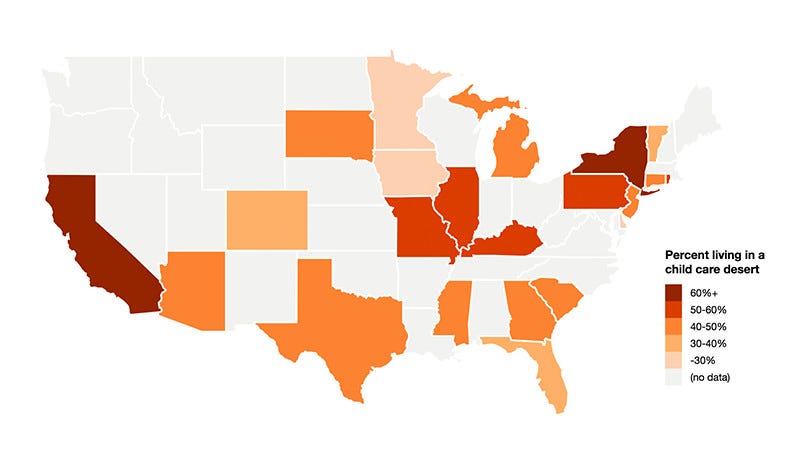 Wonderschool and WeeCare have both chosen launch states where the highest percentage of families are living in a childcare desert — WeeCare is active in Southern California, while Wonderschool is in Northern California and New York. Image courtesy of the Center for American Progress.
Wonderschool and WeeCare have both chosen launch states where the highest percentage of families are living in a childcare desert — WeeCare is active in Southern California, while Wonderschool is in Northern California and New York. Image courtesy of the Center for American Progress.
- Parent company benefits from decentralized scale. The franchise model doesn’t make sense for every business. Some companies choose to operate a number of their own stores and franchise others, particularly when they don’t want to take on risk in a new geography. However, certain types of companies benefit from scaling in a decentralized way — particularly if it’s expensive (or risky) to move into new geographies, local expertise is valuable, and transactions are mostly local. In businesses that are operationally complex and have high costs to monitoring employees, the incentive-based franchise system may also produce better results. Bird is a good example of a case where franchising makes sense — the company needs people to place and service vehicles on the ground, and Bird can benefit from market-specific expertise from franchisees about where to deploy scooters and how to work with local governments.
- Operator benefits from the company’s scale. Successful franchisors can leverage their scale to provide resources to their franchisees that individual business owners are unable to access. For example, nationwide food franchises (e.g. Subway, Dunkin Donuts) are large enough that they can negotiate favorable terms with suppliers for food and equipment, which is one reason why these franchises often have much lower prices than local restaurants. And while franchisees typically pay national ad fees to the parent company, this gives them access to expert marketers who can execute at a higher level than they could achieve alone.
- Provides opportunities for economic mobility. One of the biggest complaints about gig economy platforms and MLMs is that it’s incredibly difficult (if not impossible) for employees to advance in the organization and accumulate wealth. Some of these companies, though well-intentioned, snare contractors in stressful work with limited economic returns — for example, Uber drivers typically cap out at $17–21k annually if they work 40 hrs/wk. We’re excited about companies that allow individuals to build larger businesses like the traditional franchise model — the Franchise Business Review reports an average pre-tax income for owners of $84k, though operators with multiple successful locations can make millions.
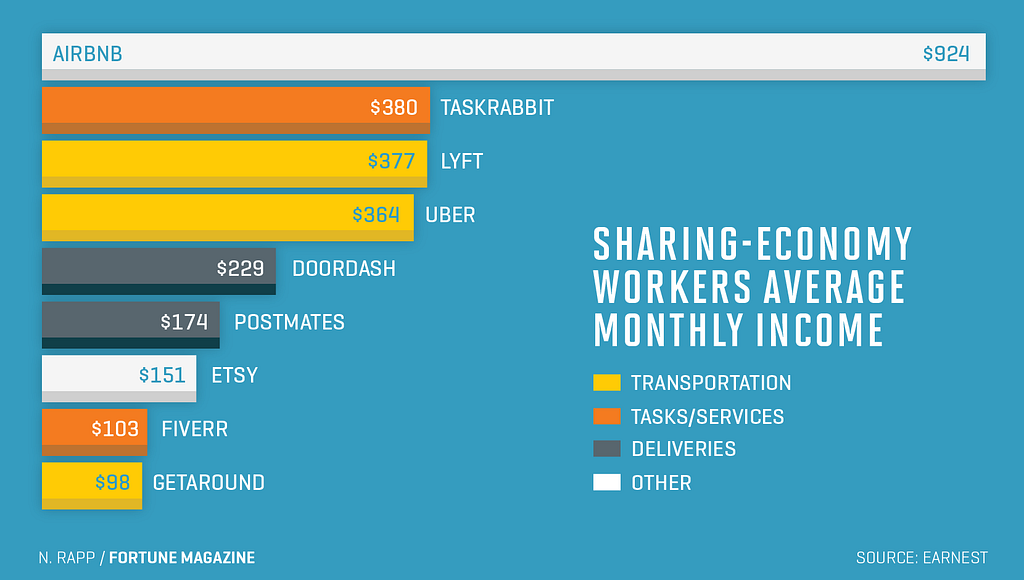 Data from lending company Earnest in 2017 showed that the average gig economy worker is still using these platforms as supplementary income (not as a full job replacement). We see big potential for Internet franchise companies to allow more workers to become fully independent with increased income and job stability. The uncapped upside of a franchise also provides financial incentives that are better aligned with performance and effort than the typical gig job.
Data from lending company Earnest in 2017 showed that the average gig economy worker is still using these platforms as supplementary income (not as a full job replacement). We see big potential for Internet franchise companies to allow more workers to become fully independent with increased income and job stability. The uncapped upside of a franchise also provides financial incentives that are better aligned with performance and effort than the typical gig job.
Franchises also provide an opportunity for economic mobility through asset appreciation. A franchisee operating in his or her local market has the ability to build a book of business that is valuable to the parent company, and can later be bought out by the company or sold at a premium to another entrepreneur who wants to operate in the same market.
- Brand provides real benefits towards consumer acquisition. Not all companies that fit within the “Internet franchise” model will require their franchisees to carry the parent company name — some will only provide the back-end infrastructure. However, the largest global franchises are in sectors like food, hospitality, housing, and childcare/education, where consumers build loyalty and trust certain brands to deliver a consistent and safe experience. We therefore expect many of these same sectors to power billion-dollar businesses under the “Internet franchise” model.
Thanks for reading, and we’d love your thoughts and feedback — feel free to email us at saar@crv.com, matt@crv.com, and twins@crv.com, and reach out to us if you’re working on something in this space!
-Saar, Matt, Justine, and Olivia
Bird’s new Platform program and the rise of the “business in a box” was originally published in Hacker Noon on Medium, where people are continuing the conversation by highlighting and responding to this story.
Disclaimer
The views and opinions expressed in this article are solely those of the authors and do not reflect the views of Bitcoin Insider. Every investment and trading move involves risk - this is especially true for cryptocurrencies given their volatility. We strongly advise our readers to conduct their own research when making a decision.
